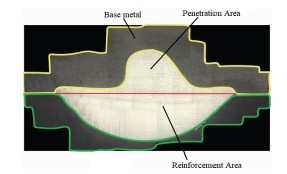- Submissions

Full Text
Novel Research in Sciences
Statistical Study of A 308l Austenitic Steel Deposit in Sae 1020 Steel
João Roberto Sartori Moreno*, Celso Alves Correa and Marcos Vinicius Tavares da Silva
Federal Technological University of Paraná, Brazil
*Corresponding author:João Roberto Sartori Moreno, Federal Technological University of Paraná, Brazil
Submission: October 31, 2019;Published: December 03, 2019
.jpg)
Volume2 Issue4December, 2019
Abstract
Welding coating of carbon steels with stainless steels allows surfaces with specific properties to be obtained from low cost materials. The quality of the coating is determined directly by the proper adjustment of the welding parameters. In this work, the MIG welding process was applied with the current imposition, the base metal was a SAE 1020 carbon steel and the addition metal were a 308L austenitic stainless steel of 1,00mm de diâmetro, with a single weld cord. The statistical method TAGUCHI “L9” was used in the experimental design and applied the Analysis of Variance of the obtained results.
Introduction
The welding processes with dissimilar metals are suitable for obtaining a surface suitable for wear or corrosion, and during welding there are variations in temperature and plastic deformations in the parts, resulting in changes in microstructure and its mechanical properties. However the welding coating process with stainless steel is defined as the deposition of a layer of stainless steel on carbon steel or low alloy steel surfaces to produce coatings with anti-corrosive properties and necessary strengths to cope with environments subject to wear due to corrosion or cavitation, and the results obtained using welding made this quite attractive [1].
Figure 1:Fixing device for preparation of weld beads.

Experimental procedure
For welding the weld bead, SAE 1020 (base metal) steels were taken with the composition: C-0.19%; Mn-0.52% and P-0.02%; S-0.05% and AISI 308L with composition: C-0.024%; S-0.005%; P-0.02%; Mn-1.12%; Si-0.75%; Cr-19.21%; Ni-10%, with dimensions of specimens of 150mm x 38mm x 8mm as shown in Figure 1.Experiment planning for TAGUCHI
When using the TAGUCHI method, one of the most important points is the correct choice of orthogonal arrangement. To generate the orthogonal matrix, orthogonal arrangement L9, with four factors and three levels each, the MINITAB software was used [2]. In the Figure 2 illustrates some important points: the yellow upper part is the base metal and the middle part is the ER308L deposition metal [3], above the red line is the metal that has penetrated in the base metal and the part below the red line is the weld reinforcement.
Figure 2:Scheme weld bead generated.

Result and Discussion
The response variables of this work were width, reinforcement, penetration and dilution [4]. The Table 1 show the average values for the determined and simulated results. Figure 3 shows a complete statistical lineation for the three fundamental welding parameters of the nine experiments, where for each of them we can individually relate them to the average, median and standard deviation.
Table 1:Results of weld bead morphology.

Figure 3:Anderson-Darling normality test for width, reinforcement and penetration.

Conclusion
The maximum value of the reinforcement was obtained in specimen number 9 with a value of 3.61mm, where the average value for this study variable was 2.86mm. It was also for experiment 9 wich presented a suboptimal deposit width value, 10.36mm, 11.3% above average. The average penetration of the specimens was 2.66mm, being the minimum value found in experiment 2. So, as the relationship width/reinforcement is a very significant factor, experiment 9 (~30%) was the one that behaved best in the present study.
References
- Qiu N, Wang L,Wu S, Likhachev D (2015) Research on cavitation erosion and wear resistance performance of coatings. Engineering Failure Analysis 55: 208-223.
- Ghosh N, Pal PK, Nandi G (2016) Parametric optimization of mig welding on 316L austenitic stainless by steel by grey-based TAGUCHI method. International Journal of Scientific Engineering Research 6: 1038-1048.
- Buchely MF, Colorado HA, Jaramillo HE (2015) Effect of smaw manufacturing process in high-cycle fatigue of ais 204 base metal using AISI 308l filler metal. Journal of Manufacturing Processes 20: 181-189.
- Kumar VV, Murugan N (2011) Effect of fcaw process parameters on weld bead geometry in stainless steel cladding. Journal of Minerals e Materials Characterization e Enginee 10: 827-842.
© 2019 João Roberto Sartori Moreno. This is an open access article distributed under the terms of the Creative Commons Attribution License , which permits unrestricted use, distribution, and build upon your work non-commercially.
 a Creative Commons Attribution 4.0 International License. Based on a work at www.crimsonpublishers.com.
Best viewed in
a Creative Commons Attribution 4.0 International License. Based on a work at www.crimsonpublishers.com.
Best viewed in 







.jpg)






























 Editorial Board Registrations
Editorial Board Registrations Submit your Article
Submit your Article Refer a Friend
Refer a Friend Advertise With Us
Advertise With Us
.jpg)






.jpg)














.bmp)
.jpg)
.png)
.jpg)










.jpg)






.png)

.png)



.png)






